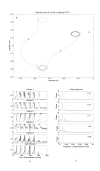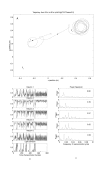Evolutionary autonomous agents and the nature of apraxia
- PMID: 15631635
- PMCID: PMC544844
- DOI: 10.1186/1475-925X-4-1
Evolutionary autonomous agents and the nature of apraxia
Abstract
Background: Evolutionary autonomous agents are robots or robot simulations whose controller is a dynamical neural network and whose evolution occurs autonomously under the guidance of a fitness function without the detailed or explicit direction of an external programmer. They are embodied agents with a simple neural network controller and as such they provide the optimal forum by which sensorimotor interactions in a specified environment can be studied without the computational assumptions inherent in standard neuroscience.
Methods: Evolutionary autonomous agents were evolved that were able to perform identical movements under two different contexts, one which represented an automatic movement and one which had a symbolic context. In an attempt to model the automatic-voluntary dissociation frequently seen in ideomotor apraxia, lesions were introduced into the neural network controllers resulting in a behavioral dissociation with loss of the ability to perform the movement which had a symbolic context and preservation of the simpler, automatic movement.
Results: Analysis of the changes in the hierarchical organization of the networks in the apractic EAAs demonstrated consistent changes in the network dynamics across all agents with loss of longer duration time scales in the network dynamics.
Conclusion: The concepts of determinate motor programs and perceptual representations that are implicit in the present day understanding of ideomotor apraxia are assumptions inherent in the computational understanding of brain function. The strength of the present study using EAAs to model one aspect of ideomotor apraxia is the absence of these assumptions and a grounding of all sensorimotor interactions in an embodied, autonomous agent. The consistency of the hierarchical changes in the network dynamics across all apractic agents demonstrates that this technique is tenable and will be a valuable adjunct to a computational formalism in the understanding of the physical basis of neurological disorders.
Figures


Similar articles
-
[Dynamic paradigm in psychopathology: "chaos theory", from physics to psychiatry].Encephale. 2001 May-Jun;27(3):260-8. Encephale. 2001. PMID: 11488256 French.
-
iSpike: a spiking neural interface for the iCub robot.Bioinspir Biomim. 2012 Jun;7(2):025008. doi: 10.1088/1748-3182/7/2/025008. Epub 2012 May 22. Bioinspir Biomim. 2012. PMID: 22617339
-
Chaotic neurodynamics for autonomous agents.IEEE Trans Neural Netw. 2005 May;16(3):565-79. doi: 10.1109/TNN.2005.845086. IEEE Trans Neural Netw. 2005. PMID: 15940987
-
[Apraxia--neuroscience and clinical aspects. A literature synthesis].Nervenarzt. 2005 Oct;76(10):1209-10, 1213-4, 1216-8, 1220-1. doi: 10.1007/s00115-005-1936-3. Nervenarzt. 2005. PMID: 15937712 Review. German.
-
[Functional imaging insights into the pathophysiology of apraxia].Fortschr Neurol Psychiatr. 2008 Jul;76(7):402-12. doi: 10.1055/s-2008-1038206. Fortschr Neurol Psychiatr. 2008. PMID: 18604774 Review. German.
References
-
- Beer R. A dynamical systems perspective on environment agent interactions. Adapt Behav. 1995;72:173–215.
-
- Clark A. The dynamical challenge. Cognitive Sci. 1997;21:461–481. doi: 10.1016/S0364-0213(99)80030-5. - DOI
-
- Thelen E, Smith L. A dynamics system approach to the development of cognition and action. Cambridge MA: MIT Press; 1994.
-
- Van Gelder T. What might cognition be, if not computation? J Philosophy. 1995;92:345–381.
Publication types
MeSH terms
LinkOut - more resources
Full Text Sources

